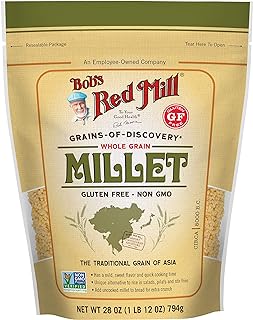5 important factors worth considering when looking for the best millets
When choosing millets for your diet, it’s important to consider factors like nutrition, taste, cooking options, and environmental impact. The decisions we make about the millets we eat can have a big impact. It’s crucial to understand these factors to improve our health and support sustainable food practices. By learning about the benefits of millets for nutrition and sustainability, we can see how important these ancient grains are in our lives today.
See our guide to the best millets.
Quality
When choosing millets to eat, it’s important to focus on quality. Quality millets not only make your meals healthier but also help support sustainable farming. If you opt for millets that are grown organically without chemicals, you are taking care of your health and supporting farmers who use ethical and environmentally friendly practices. In a market full of choices, paying attention to details like color, texture, and aroma can help you pick the best millets.
Choosing high-quality millets is more than just a decision, it’s a commitment to your overall well-being and to taking care of the environment. When you choose superior millets, you are investing in your health, supporting farmers, and helping to protect our planet. Try out different types of millets to find the ones that you enjoy and that align with your values. Remember, quality millets are not just grains; they show a thoughtful and responsible approach to eating that goes beyond your plate.
Price
When buying millets, it’s important to consider the price. Some people think millets cost more than other grains, but their health benefits are worth it. Choosing millets is like investing in your health. Even though they might be more expensive, the long-term advantages of eating millets are clear. They are full of important nutrients, are gluten-free, and are produced sustainably. Instead of thinking of millets as just another food, seeing them as a superfood that boosts your health can change how you see the price.
Looking at the cost of millets should also include thinking about overall health expenses. Eating millets, which are full of nutrients, can help prevent health problems. This could save money on medical bills in the future. It’s important to understand that making healthy food choices can impact your financial well-being. Even though millets may seem pricey upfront, the savings on healthcare and the long-term benefits they provide are worth it. Making millets a key part of a balanced diet isn’t just about the cost but about how they can improve your health and life quality.
Organic vs. conventional
When choosing between organic and conventional millets in the store, conscious consumers face a tough decision. The organic millets promise purity, being grown without synthetic pesticides or GMOs. On the other hand, conventional millets are more efficient and affordable for budget-conscious shoppers. While organic millets are seen as better for the environment and our health, conventional millets raise concerns about chemicals and their impact on nature. So, what should mindful consumers choose?
To figure out the best option, one needs to consider personal values and practical matters. Organic millets are grown using natural methods, providing a healthier and cleaner choice. By choosing organic, one is supporting sustainable farming practices and helping to protect the environment. However, conventional millets, despite their downsides, are still popular because they cost less. As we navigate through these choices, it all comes down to what matters most to each individual – whether it’s health and sustainability or sticking to a budget.
Source/origin
When you buy millets, it’s important to know where they come from. Getting millets that are locally grown or from trusted suppliers is key. This ensures good quality and supports sustainable practices. Buying millets grown in your area or from farmers who grow them ethically helps your local economy and reduces the pollution from transporting them. Knowing where your millets are from makes you confident that they are pure and genuine, grown with care for the environment.
Choosing millets with a clear source helps you connect with your food and understand where it comes from. Supporting farmers who use organic and eco-friendly methods means you’re investing in healthy products that also benefit the planet. By buying millets from a trustworthy source, you’re not just making a purchase – you’re showing you care about sustainability and ethical choices. Knowing the origin of your millets is not only about what you eat, but also about the values you believe in and the impact you want to have on the world.
Nutritional value
Millets are nutritious grains that offer many health benefits. They are packed with important nutrients like fiber, magnesium, and iron, and are a good source of protein for plant-based diets. What makes millets special is how versatile they are. You can use them in porridge for breakfast, in salads, or in baking to boost the nutritional value of your meals.
Millets have a low glycemic index, making them a great choice for managing blood sugar levels. They are also gluten-free and full of antioxidants, making them a well-rounded option for nutrition without sacrificing taste or variety. In a world where people have diverse dietary preferences and prioritize health, millets are a nutritious choice that can meet different dietary needs and promote overall well-being.
Conclusion
In conclusion, the rise of millet in recent years shows a important move towards healthy and sustainable food choices. As we see a renewed interest in these ancient grains, it is clear that choosing millet is more than just a trend – it’s a way to support local farmers, promote biodiversity, and improve our health. By adding millet to our diets, we honor our agricultural past and pave the way for a better, more environmentally-friendly future. Want more info on effin mom, check the best effin mom.
